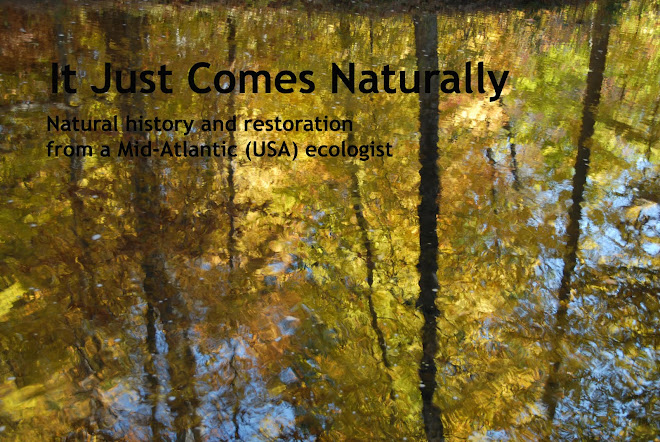 |
| Three of "the girls" |
Since I'd only been getting anecdotal reports over the last few months on our four goats' efforts to control invasive plants, I asked my stewardship staff to join me in the field yesterday to review progress first-hand.
The staff has created a portable electrified enclosure that they have been moving around in a dense, overgrown thicket. The staff members have found that the goats like the herbaceous portions of woody plants, but they won't eat fibrous stems. So, they'll strip the leaves and tender stems from porcelain-berry (Ampelopsis brevipedunculata), multiflora rose (Rosa multiflora), shrub & Japanese honeysuckles (Lonicera spp.), Asian bittersweet (Celastrus orbiculatus), and privet (Ligustrum spp.). They clear the patches to the ground, but leave the woody stems standing. The staff has decided that the way to proceed is then manually to remove the stripped woody stems, either by uprooting them or by cutting the stems and painting herbicide on the cut stumps.
 |
| Foreground cleared by the goats last week |
Some of the shaded patches that the goats cleared earliest (about two months ago) and which the staff members did not subsequently address by hand have begun to resprout. It would be feasible to return the goats to those patches again, but so far the regrowth has been very modest and would provide very little food, so the fenced enclosure would have to be moved almost daily - a pain in the neck. Instead, the staff will go back and address the regrowth by hand.
 |
| Cleared patch on the right originally looked like the uncleared thicket on the left |
There are some gaps without tree cover in the thicket. These sunny patches have been overwhelmed by porcelain-berry. While this plant is among the goats' favorites, the plant can recover from browsing quickly when it's growing in the sun. The patches cleared by the goats are now lushly green again. We've decided to move the goats back to these patches, let them clear the porcelain-berry for a second time to expose the soil surface (and hidden obstacles like rocks and tree trunks), and then to mow the patches to control the porcelain-berry until we have a chance to plant trees this autumn.
My overall assessment after a few months' experience? First, simply managing the goats is a lot of work for the staff because the goats have to be herded out to the thicket each morning and then returned to their overnight pen in the evening. Furthermore, the portable enclosure needs to be moved frequently. And, personally, I'm disappointed that the goats largely ignore the woody stems; they won't even girdle (let alone eat) the huge Asian bittersweet and porcelain-berry vines (though, surprisingly, they have girdled some of the younger cherry trees growing in the thicket). I'll let this experiment go on for a while, but the staff would like to enlarge the herd to make it more cost-effective; right now, I just don't see that happening.





















































